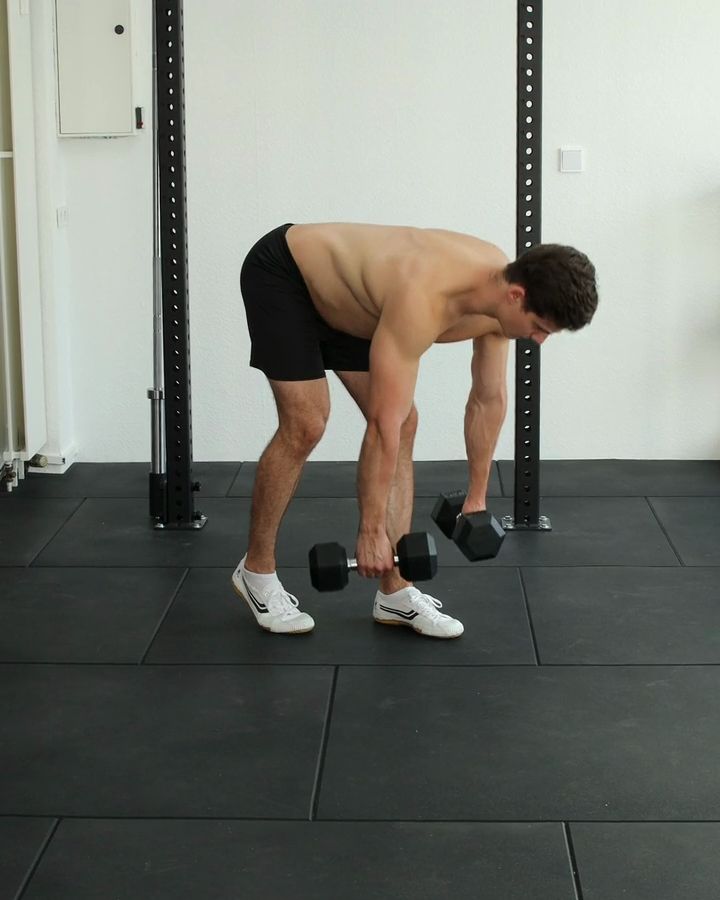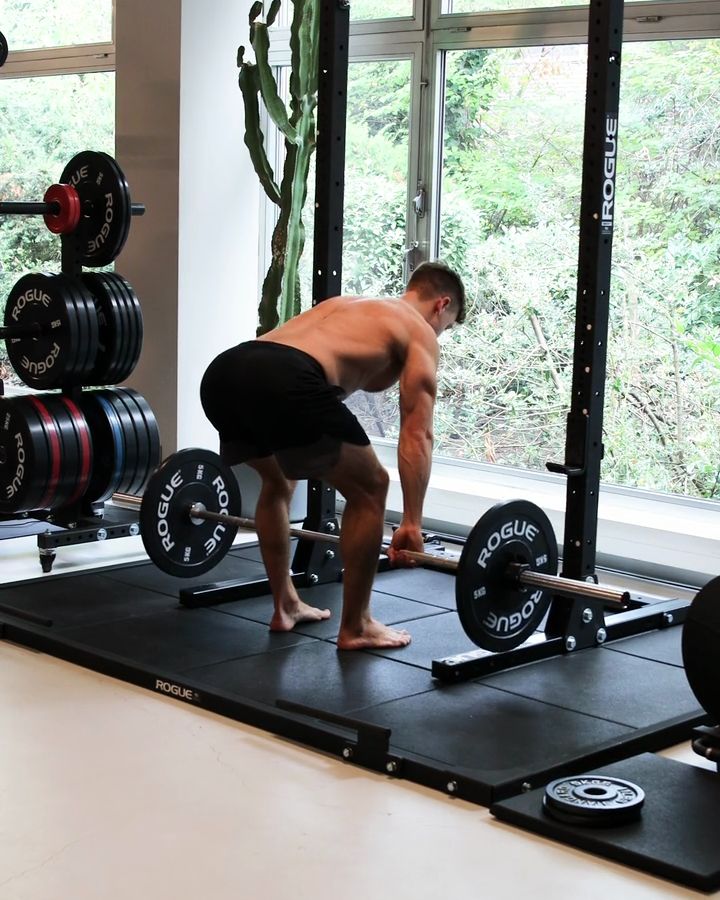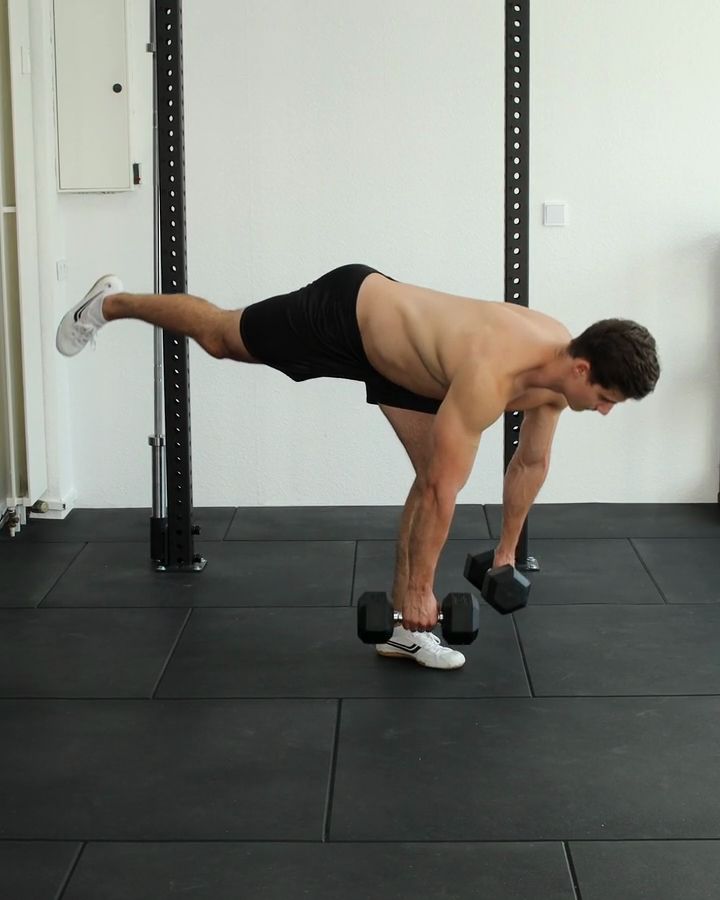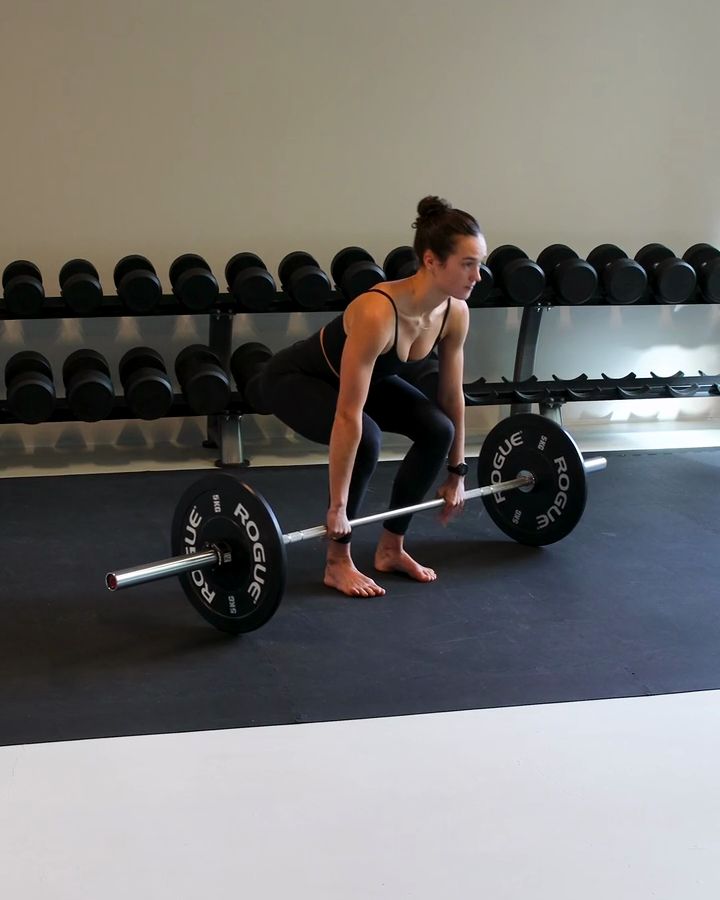Split Stance Romanian Deadlift with dumbbells
The Split Stance RDL, also called Split Stance Romanian Deadlift, is an effective exercise for strengthening the glutes, back extensors, and hamstrings. The split stance position allows for targeted activation of one leg while the other leg provides stability. This is the advantage of this variation compared to the single-leg deadlift, where there is no stabilizing leg for support. However, both exercises train the muscles in the same way.
Another related exercise is the RDL (Romanian Deadlift) where both feet remain on the ground.
Necessary equipment
~71a250d87b54c382097fe3ad87f5e64a.png?alt=media)
Split Stance Romanian Deadlift with dumbbells - the correct execution
- Start in a short stride position with the left leg in front
- Hold the dumbbells next to your body with arms extended
- Bend your hips and bring the dumbbells towards the floor
- Make sure the spine is straight and keep the shoulder blades down at the back (retraction / depression)
- Pull yourself back to the starting position
- Work in the greatest possible range of motion
- The specified weight of the dumbbells refers to each individual dumbbell
The exercise Split Stance Romanian Deadlift is intended to be used as a mobility, hypertrophy exercise.
Which muscles are trained by Split Stance Romanian Deadlift?








Primary trained muscles for Split Stance Romanian Deadlift
Hamstrings - The hamstrings are muscle groups located at the back of your thigh. They help you bend your knee and extend your hip.
Glutes - The gluteus maximus is the large muscle in your buttocks. It is important for extending the hip, moving your leg backward, and stabilizing the hip joint.
Secondary trained muscles for Split Stance Romanian Deadlift
Lower Back - The erector spinae muscle runs along your spine and helps you extend your back and stand upright.
Similar exercises to Split Stance Romanian Deadlift
Romanian Deadlift with a barbell
The Romanian deadlift, also known as the "Romanian Deadlift" or simply "RDL," is an excellent exercise for strengthening the posterior chain, particularly the lower back, hamstrings, and glutes. Unlike the classic barbell deadlift, where the movement starts from a deeper position, the Romanian deadlift keeps the knee position almost unchanged, with the focus on a controlled hip hinge. This allows for targeted activation of the posterior muscle groups while also being gentle on the knee joints.
The origin of the Romanian deadlift dates back to 1990 when a Romanian weightlifter introduced this technique in the United States to provide Olympians with a new method for developing strength and athleticism. Since then, the exercise has become a staple in gyms worldwide and can be performed with both barbells and dumbbells.
Single Leg Deadlifts with dumbbells
Single-leg deadlifts with dumbbells are an effective exercise for improving balance and stability. In this variation, the weight is carried on one leg, which particularly engages the posterior leg muscles and core. Compared to the classic deadlift, the single-leg deadlift with dumbbells demands more balance since all the weight is supported by one leg. It should not be confused with the sprinter deadlift, where the back leg lightly touches the ground during the movement instead of hovering freely in the air.
Conventional Deadlift with a barbell
The conventional deadlift, also known as the classic deadlift, is a fundamental exercise that strengthens the back, glutes, and legs. When performed with proper technique, it offers significant benefits but requires precise execution to avoid back injuries. Especially advanced athletes can lift heavy weights with this exercise. Variants such as the dumbbell deadlift or using a Smith machine are suitable for beginners.
This could also be interesting
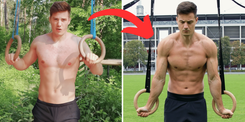
Calisthenics Body Transformation – How to Build a Strong, Lean, and Athletic Physique
Transform your body with Calisthenics! Build muscle, burn fat & achieve a shredded physique with bodyweight training. See real before & after results!

The Best Fitness Apps in 2025: Our Top 10 Recommendations
Don’t miss the best fitness apps of 2025: surprising favorites, free options, and perfect tools for your workouts. Find the ideal app today!
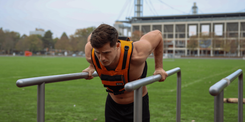
Complete Calisthenics Skills List – 40+ Exercises from Beginner to Pro
Which calisthenics skills should you learn first? And which ones will really help you progress? In this article, you’ll find a complete list of over 40 exercises – from the very basics to the toughest moves for professionals. Each exercise comes with instructions, so you can immediately integrate them into your training.
